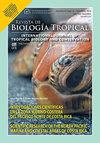Effects of microplastics pollution on the abundance and composition of interstitial meiofauna
IF 0.6
4区 生物学
Q4 BIOLOGY
引用次数: 1
Abstract
Introduction: Pollution by microplastics is a global problem in marine environments, and impacts microorganisms and ecosystems at several spatial levels. Sandy beaches are depositional environments where microplastics tend to accumulate in large quantities. The co-occurrence of interstitial meiofauna and microplastics in sand grains raises the question on whether the accumulation of microplastics in the sediments affects the abundance and composition of the meiofaunal communities. Objective: To test the hypothesis that microplastics affect the meiofauna of urban sandy beaches. Methods: We studied the three main urban sandy beaches of Santa Marta, Colombia: El Rodadero, Santa Marta Bay, and Taganga. All are similar in morphology and external pressures and differ from other beaches in the region. In April 2019 we collected 81 sand samples, equally distributed in the intertidal zone (upper, mid, and lower intertidal levels). We applied generalized linear models to abundance, and multivariate permutational tests to community composition. Results: We identified 17 taxonomic groups of meiofauna, and microplastic particles (mainly 45-500 micron fibres) evenly distributed across beaches and intertidal levels. There was more meiofauna at the mid intertidal level, and in fine and medium grain sediment. At the lower intertidal level, sites with more microplastics had less meiofauna. Microplastics “explained” 39 % of the variation in meiofaunal communities at lower intertidal levels. Conclusions: The accumulation of microplastics has a negative impact on these meiofaunal interstitial communities. This is not surprising: microplastics occupy the same physical space as these animals, presumably modifying the structure of sediments and the composition of interstitial water. Objective: As a step forward on that direction, we have here analysed the distribution of the abundance of microdebris and major interstitial meiofaunal groups in three urban sandy beaches in Santa Marta region, Colombia, and possible relation among both factors. Methods: We selected the three main urban sandy beaches in Santa Marta, Northern Colombia: El Rodadero, Bahía de Santa Marta, and Taganga. All of them are very similar to each other due to its morfolophy and extern pressions, and differ starkly from other beaches in the region. Sampling was performed in April 2019 with a 81 samples in total equitably distributed in the supratidal zone, intertidal zone, and subtidal zone. In each point, we collected samples for microplastics quantification, meiofaunal community characterization, and granulometric analysis. Results: We extracted a total of 1131 debris particles, dominated by fibres ranging between 45-500 microns. Generalised linear models showed that microdebris were uniformly distributed across beaches and tidal levels, whereas meiofaunal abundances were significantly affected by the granulometry and tidal level. We detected a significant correlation between the abundance of microplastics and meiofauna at those levels, although with a very small estimate. Furthermore, our permutational multivariate tests showed that the abundance of microdebris significantly explained the 39.3% of the variation of the meiofaunal communities at the lowest tidal levels. Conclusions: Our result suggested that microdebris accumulating amongst the beach sand grains negatively impact meiofaunal diversity. This is not surprising, given that microdebris occupy the same physical space than these animals, presumably modifying the structure of the sediments and the composition of the interstitial water.微塑料污染对间隙小型底栖生物丰度和组成的影响
简介:微塑料污染是海洋环境中的一个全球性问题,在几个空间层面上影响微生物和生态系统。沙滩是微塑料易于大量积累的沉积环境。间隙小型生物和微塑料在沙粒中的共存提出了一个问题,即微塑料在沉积物中的积累是否会影响小型生物群落的丰度和组成。目的:验证微塑料影响城市沙滩小型动物的假说。方法:我们研究了哥伦比亚圣玛尔塔的三个主要城市沙滩:El Rodadero、圣玛尔塔湾和Taganga。所有海滩在形态和外部压力上都相似,与该地区其他海滩不同。2019年4月,我们收集了81个沙子样本,平均分布在潮间带(潮间带上层、中层和下层)。我们将广义线性模型应用于丰度,并将多元排列检验应用于群落组成。结果:我们确定了17个小型动物分类群,微塑料颗粒(主要是45-500微米的纤维)均匀分布在海滩和潮间带。潮间带中段、中细粒沉积物中小型底栖生物较多。在较低的潮间带,微塑料较多的地方小型底栖生物较少。微塑料“解释”了潮间带较低水平小型动物群落39%的变化。结论:微塑料的积累对这些微小动物间质群落有负面影响。这并不奇怪:微塑料与这些动物占据着相同的物理空间,可能会改变沉积物的结构和间隙水的组成。目的:作为朝着这一方向迈出的一步,我们在这里分析了哥伦比亚圣玛尔塔地区三个城市沙滩上微型生物和主要间质小型动物群的丰度分布,以及这两个因素之间的可能关系。方法:我们选择了哥伦比亚北部圣玛尔塔的三个主要城市沙滩:El Rodadero、Bahía de Santa Marta和Taganga。由于其珊瑚礁和外部压力,所有海滩都非常相似,与该地区的其他海滩截然不同。采样于2019年4月进行,共有81个样本均匀分布在潮上带、潮间带和潮下带。在每一点上,我们都收集了用于微塑料定量、小型动物群落表征和粒度分析的样本。结果:我们总共提取了1131个碎屑颗粒,主要由45-500微米的纤维组成。广义线性模型表明,微型生物在海滩和潮汐水平面上均匀分布,而小型生物的丰度则受到粒度和潮汐水平面的显著影响。我们检测到,在这些水平上,微塑料的丰度与小型底栖动物之间存在显著相关性,尽管估计值很小。此外,我们的排列多变量测试表明,微ebris的丰度显著解释了最低潮汐水平下小型动物群落39.3%的变化。结论:我们的研究结果表明,在海滩沙粒中积累的微型ebris对小型底栖生物多样性产生了负面影响。这并不奇怪,因为微型ebris与这些动物占据着相同的物理空间,可能会改变沉积物的结构和间隙水的组成。
本文章由计算机程序翻译,如有差异,请以英文原文为准。
求助全文
约1分钟内获得全文
求助全文
来源期刊

Revista De Biologia Tropical
生物-生物学
CiteScore
1.80
自引率
0.00%
发文量
23
审稿时长
4-8 weeks
期刊介绍:
The Revista de Biología Tropical / International Journal of Tropical Biology and Conservation is a mainstream scientific journal published since 1953 and covered by Web of Science; Science Citation Index; Current Contents; Google Scholar; Scopus, SciELO and nearly 50 additional indices.
A double blind system guarantees you a fair evaluation, and our world class editorial and scientific boards provides a first decision in three working days. The journal is Full Open Access and is widely read where your article can have the highest real impact.
Since its beginning in 1953, the Revista follows these principles: objective and independent evaluation of all manuscripts; transparency in all processes; ethical use of procedures, data, specimens and subjects; fair treatment of all parties; and absolute predominance of scientific rigor over any other aspect.
 求助内容:
求助内容: 应助结果提醒方式:
应助结果提醒方式:


